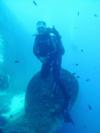
|
Were these last two dives with tank rentals? Were they the same capacity tanks as previously?
I usually use my own tanks, however, I’ve had rentals before, where the o-ring was old, cracked, ratty, just basically bad, however viable enough that I didn’t get that huge "whoosh" of bubbles at depth. I’m not sure air loss via a bad o-ring can be responsible for cutting your air in half (without you noticing the bubble stream), however, it can cut capacity somewhat.
Were these last two dives in colder water, in a current, or have a deeper dive profile? Colder water, and fighting a current, can increase your SAC. Deeper dives, as you know from OW, will exponentially exhaust your air faster.
Unless your last two dives were the exact same profile as your original dives, you won’t experience the same exact SAC (surface air consumption measure of your breathing rate).
|
|

|
Good SAC rate is something that some have and others do not. Part is the physical makeup of the individual. As pointed out alerady unless the dives were the same profile you were likely to have different rates.
The more you dive and streamline your self and equipment, the more overall comfort you have in the water the better you will find your SAC.
I seldome can make more than 2 hrs on my HP 100’ at 50’ . . . but that is me in the cooper river :-)
YMMV
Best Fishes!! [
|
|

|
mo - 7/03/2008 10:55 AM 
Calculating Air Consumption:
That first factor depth, means that to measure our air consumption we need to do it in relation to the surface or we are comparing apples with oranges for every dive we do. If we did two identical dives one at 10 meters and one at 20 meters then we should expect to use twice the amount of air for the 20 meter dive. By converting our air consumption to an equivalent value as if we were standing on the surface, we can compare different dives and see if we are generally improving or not.
The calculations for metric divers are fairly straight forward. Take a 20 minute dive to 20 meters where you used 140 bar and you were diving with a 10 litre tank:
140 bar x 10 litre cylinder = 1400 litres consumed during the dive.
1400 litres / 20 minutes = 70 litres / min air consumption rate at 20 meter depth.
At 20 meters, the air is 3 times denser than at the surface so we divide by 3 to get a 23.3 litres /min Surface Air Consumption Rate.
For imperial divers, the calculations get a little more complex with the addition of the way tanks are described. In this case, an 80 cubic foot tank is the volume of gas it contains at it’s working pressure. Not it’s true internal volume at normal atmospheric pressure which is how metric tanks are defined.
So lets take a 20 minute dive to 66 feet where you used 2000 psi and were diving with an 80 cubic foot tank rated to 3000 psi working pressure.
80 cubic feet x 2000 psi / 3000 psi = 53.3 cubic feet of air used.
53.3 cubic feet / 20 minutes = 2.6 cubic feet / minute at 66 feet depth.
At 66 feet the air is 3 times denser than at the surface and so we divide by 3 to get a 0.89 cubic feet per minute Surface Air Consumption Rate.
|
|

|
mo - 7/03/2008 11:23 AM 
|
|

|
A new diver will go through air a lot quicker than an experienced diver, so don’t worry about consumption so much. As you become more experienced and comfortable under water, your respiration rate will slow and you’ll breathe more deeply, which will increase your bottom time. My initial SAC was around 1.0 SCFM, now I’m down to less than 0.3 SCFM (standard cubic feet per minute) on easy dives. If you use a dive computer and download software, you can determine this consumption rate.
As for a tip to decrease consumption, try to think of your breathing cycle in thirds. First third - inhale. Try not to gulp, just sip the air. Second third - exchange. If you don’t allow the air you just inhaled to exchange carbon dioxide for oxygen in your lungs, you’re wasting it. So after breathing in, allow the air to sit in your lungs a few seconds. DON’T HOLD YOUR BREATH. Just don’t exhale immediately after breathing in. Final third - exhale. Try to S L O W L Y exhale, not just blow it all out at once. Let it dribble out. You’ll need to practice this technique but all experienced divers do it in some fashion. Watch an experienced divemaster’s respiration rate and try to match it - you’ll find there is a significant difference between the exhale time and inhale/exchange time.
|
|

|
I think it’s been mentioned above but it depends on how deep you were, I’m sure your first few dives weren’t as deep as your more recent ones. Enter Boyles Law, the pressure-volume relationship. Your lungs are flexible containers and so as you go deeper the amount of air required to fill them increases, as you have to overcome the pressure pushing in on them. So you don’t need to find out your SAC, but rather you RMV. Your SAC rate is only good for the depth you were at when you made an effort to calculate it. An RMV is good for all depths because when you use it to plan dives it takes into account the depth. Ex. .6cuft/min/ATA. You should be able to find an RMV calculator online.
|
|